
Dec. 18, 2018
Feature Story
Artifacts In Space
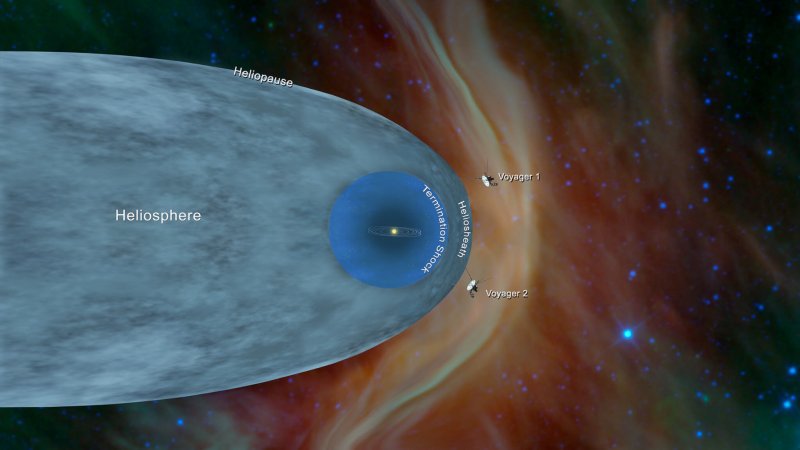
Voyager 2 entered interstellar space last month, becoming a space “artifact” of our civilization.Image credit: NASA.
All of a sudden, we have spacecraft and objects both coming into our solar system and leaving for interstellar space. This is highly unusual, and very intriguing.
The departing spacecraft is Voyager 2, which launched in 1977 and has traveled spaceward some 11 billion miles. It has now officially left the heliosphere, the protective bubble of particles and magnetic fields created by the sun. In this it follows Voyager I – which left our solar system in 2012 — and managers of the two craft have reason to think they can travel until they cross the half-century mark.
This is taking place the same time that scientists are puzzling over the nature of a cigar-shaped object that flew into the solar system from interstellar space last year.
Nobody knows what the object – called Oumuamua, Hawaiian for “first messenger,” or “scout” – really is. The more likely possibilities of it being a comet or an solar system asteroid have been found to be inconsistent with some observed properties of the visitor, and this has led some senior scientists to even hypothesize that it just might be an alien probe.
The likelihood may be small, but it was substantial enough for Harvard University Astronomy Department Chairman Avi Loeb to co-author a paper presenting the possibility. In the Astrophysical Journal Letters, Loeb and postdoc Shmuel Bialy wrote that the object “may be a fully operational probe sent intentionally to Earth vicinity by an alien civilization.”
They also say the object has some characteristics of a “lightsail of artificial origins,” rather like the one that Loeb is working on as chairman of the Breakthrough Starshot advisory committee. The well-funded private effort is hoping to develop ways to send a fleet of tiny lightsail probes to the star system nearest to us, Alpha Centauri.
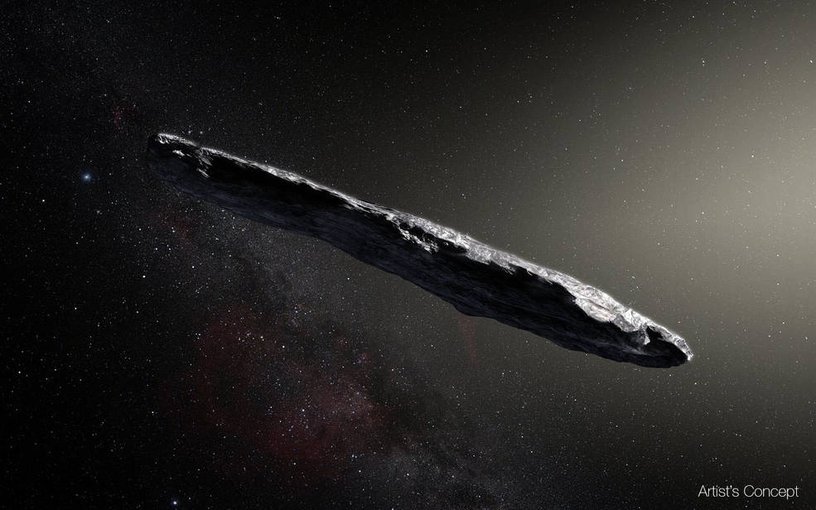
This artist’s impression of the first detected interstellar visitor: Oumuamua. This object was discovered in October 2017 by the Pan-STARRS 1 telescope in Hawaii. Subsequent observations from ESO’s Very Large Telescope in Chile and other observatories around the world show that it was traveling through space for millions of years before its seemingly chance encounter with our star system. But some scientists wonder: might it be instead a probe sent into the cosmos by intelligent creatures? Credit: NASAImage credit: European Southern Observatory/M. Kornmesser.
Put the two phenomenon together — the coming into our solar system and the going out — and you have a pathway into the world of alien “artifacts,” products of civilizations near and far. They are the kind of “technosignatures,” the potential or actual handwork of intelligent beings, that NASA is now interested in learning about more.
We know this because during a fall conference in Houston convened by NASA at the request of members of Congress, scientists were brought together to discuss many different kinds of potential signs of intelligent extraterrestrial life. While artifacts were one of many topics discussed, the term carries a quite magnetic pedigree.
So far, that meaning is of course fictional, or a misreading of actual features. There is perhaps most famously the monoliths from the movie “2001: A Space Odyssey” and then the myriad sightings of alien spacecraft that turn out to be anything but that.
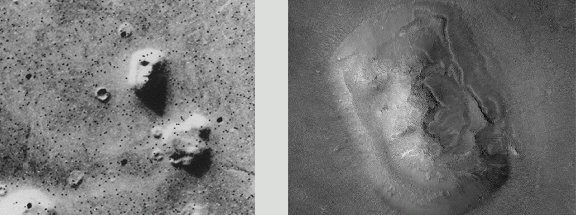
Left: Image taken by VIking 1 in the mid 1970s led to years of discussion about Martian beings having at one time carved what appeared to be a gigantic face. Right: High-resolution image from the Mars Orbiter Camera about the Mars Global Surveyor spacecraft shows the famous “Face on Mars” in detail, clearly showing it to be a natural geological formation. Credit: NASA/MSSSImage credit: NASA/MSSS.
And then there’s the “Face on Mars.”
The original image taken by Viking 1 looked somewhat like a human face. The feature, found in the region where the highlands meet the northern plains of Mars, was subsequently broadly popularized as a potential “alien artifact,” with even a major motion picture.
So many people were convinced that an image had been sculpted on the surface of Mars that NASA ultimately put out a substantial release in 2001 to make clear that the face was actually a mountain.
That was after the Mars Global Surveyor orbiter determined that the “face” was created by unusual reflections in an otherwise ordinary Martian mountain.
So alien artifacts surely and properly have a steep hill to climb before they can be taken at all seriously.
But does that mean they shouldn’t be taken seriously at all? Loeb clearly says no, that they are a potential source of important and compelling science, even if they turn out to be unusual but natural phenomena.
And then there’s the question raised in the Houston “technosignatures” conference: What actually is meant by an artifact?
Longtime SETI scientist and advocate Jill Tarter, for instance, wondered if the signatures of intelligent civilizations could be imprinted on neutrinos. She said that a leak of the radioactive isotope tritium, which has a short 12-year half-life, could also signal the presence of advanced life because (unless it’s near a supernova) it would have to come quite recently from a nuclear reactor.
Taking it further, she and others argued that artifacts of intelligent life would include many atmospheric and planetary changes that could only be accomplished by intelligent beings. For instance, the presence of unnatural pollutants such as chloroflurocarbons (CFCs) or sulfur hexafluoride (SF6) in an exoplanet atmosphere would, in this view, be an “artifact” of civilization.
Back, now, to Voyager 2, which is for sure an extraterrestrial artifact.
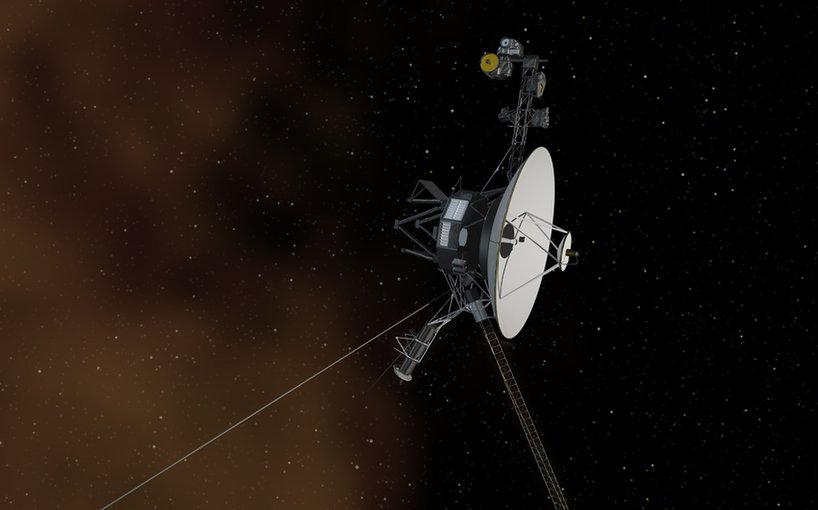
The Space Between: This artist's concept shows the Voyager 1 spacecraft entering the space between stars. Interstellar space is dominated by plasma, ionized gas (illustrated here as brownish haze), that was thrown off by giant stars millions of years ago.Image credit: NASA/JPL-Caltech.
Voyager 2 was launched by NASA in August, 1977 to study the outer planets. Part of the larger Voyager program, it was launched 16 days before its twin, Voyager 1, on a trajectory that took longer to reach Jupiter and Saturn but enabled further encounters with Uranus and Neptune.
Both have traveled far their original destinations. The spacecraft were built to last five years and conduct close-up studies of Jupiter and Saturn. With the spacecraft holding up despite the rigors, additional flybys of the two outermost giant planets, Uranus and Neptune, proved possible, and then the Voyagers were directed to interstellar space.
Their five-year lifespans have stretched to 41 years, making Voyager 2 NASA’s longest running mission ever.
At the on-going American Geophysical Union annual meeting, NASA project manager Suzanne Dodd said she believed that Voyager 2 can keep functioning for 5 to 10 more years in this new region of space, though not with all its instruments operating.
The greatest concerns about keeping the probes operating, she said, involve power and temperature. The nuclear-powered Voyager 2 loses about 4 watts of power a year, and mission scientists have to shut off systems to keep instruments operating.
Voyager 2 is very cold — about 3.6 degrees Celsius and close to the freezing point of hydrazine — leading to concerns about the probe’s thruster that uses this fuel. Dodd says she’s set a personal goal of keeping at least one of the Voyagers going until 2027, making it a 50-year mission.
The cameras for both probes are no longer on. But before the camera on Voyager 1 was decommissioned, it took the iconic “Pale Blue Dot” picture of the Earth.
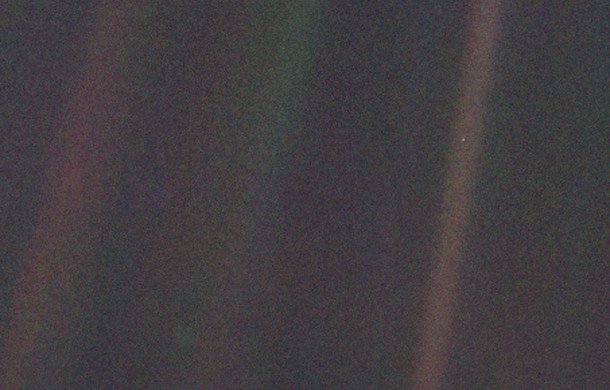
This “Pale Blue Dot” image was captured in 1990, when Voyager 1 was about 4 million miles from Earth. The spacecraft is now more than 13 billion miles from where it launched. Credit: NASAImage credit: NASA.
In preparation for the potentially deep space travels for the Voyager spacecrafts, both were fitted with a greeting for any intelligent life that might be encountered.
The message is carried by a phonograph record – -a 12-inch gold-plated copper disk containing sounds and images selected to show the diversity of life and culture on Earth. The contents of the record were selected for NASA by a committee chaired by space scientist and popularizer Carl Sagan. He and his associates assembled 115 images and a variety of natural sounds to give a sense of what Earth and Earthlings are like.
So are the Voyagers now artifacts from our civilization, messengers awaiting discovery by some distant beings?
Perhaps. But they actually have not even left the solar system, and won’t be leaving anytime soon. They are in what is considered interstellar space, but the boundary of our solar system is beyond the outer edge of the Oort Cloud, a collection of small objects that are still under the influence of the sun’s gravity.
The width of the Oort Cloud is not known precisely, but it is estimated to begin at about 1,000 astronomical units (AU) from the sun and to extend to about 100,000 AU. One AU is the distance from the sun to Earth. It will take about 300 years for Voyager 2 to reach the inner edge of the Oort Cloud and possibly 30,000 years to fly beyond it.
Astronomers have long predicted that objects from other solar systems get shot out into space and arrive in our system.
The first identified interstellar object to visit our solar system, Oumuamua, was discovered in late 2017 by the University of Hawaii’s Pan-STARRS1 telescope as part of a NASA effort to search for and track asteroids and comets in Earth’s neighborhood.
While originally classified as a comet, observations revealed no signs of cometary activity after it was slingshotted around the sun at a remarkable 196,000 miles per hour.
Oumuamua seems to be a dark red highly-elongated metallic or rocky object that (at last analysis) is somewhere between 400 and 100 meters long and is unlike anything normally found in the solar system. Researchers hypothesize that the shape and size suggest that the object has been wandering through the Milky Way, unattached to any star system, for hundreds of millions of years.
Immediately after its discovery, telescopes around the world were called into action to measure the object’s trajectory, brightness and color. Combining the images from several large telescopes, a team of astronomers led by Karen Meech of the Institute for Astronomy in Hawaii found that Oumuamua varies in brightness by a factor of 10 as it spins on its axis every 7.3 hours.
No known asteroid or comet from our solar system varies so widely in brightness, with such a large ratio between length and width. The most elongated objects we have seen to date are no more than three times longer than they are wide.
“This unusually big variation in brightness means that the object is highly elongated: about ten times as long as it is wide, with a complex, convoluted shape,” said Meech. “We also found that it had a reddish color, similar to objects in the outer solar system, and confirmed that it is completely inert, without the faintest hint of dust around it.”
Oumuamua is headed out of the solar system now, so it’s unlikely more will be learned about it. And with its odd shape and features, it clearly remains something of a mystery.
And that’s where Harvard’s Avi Loeb comes in. Especially due to the remarkably fast speed with which Oumuamua entered the solar system, he argues that a probe sent by intelligent others cannot be ruled out, that science must be open minded.
“There is data on the orbit of this object for which there is no other explanation” than that it is the product of intelligent others,” he has said. “The approach I take to the subject is purely scientific and evidence-based.”
Others strongly disagree. But the views of the chairman of the Harvard astronomy department are nonetheless an intriguing part of the story.